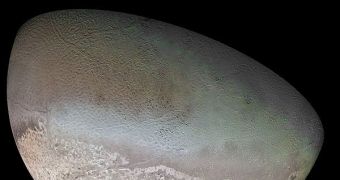According to a paper published in the latest issue of the esteemed scientific journal Icarus, it would appear that Triton, one of the moons orbiting Neptune, may host an ocean of liquid water underneath its thick, solid and icy surface.
If that is true, then this would definitely be the farthest ocean from the Sun within our solar system. This is remarkable in itself, since Triton is estimated to endure surface temperatures of around minus 235 degrees Celsius (minus 391 degrees Fahrenheit).
At this temperature, ice is stronger than granite is on Earth, meaning that the icy surface of the Neptunian moon may in fact be tougher than our planet's. Scientists say that the volcanoes on this world tend to spew out cold gases and liquid water, rather than hot magma.
Definitely one of the most impressive traits of Triton is that it orbits the ice giant in the opposite direction to its rotation, the only large moon in the solar system known to do so. Generally, retrograde orbits are very rare.
This also suggests that the object did not form around Neptune, and that it was captured by the massive planet's gravitational pull later on in the history of the solar system. Astronomers believe that it originated in the inner edge of the Kuiper Belt, just like the dwarf planet Pluto.
The NASA Voyager 2 spacecraft demonstrated in 1989 that Triton is geologically active, and scientists are now using that study as a basis for research suggesting that an ocean of liquid water may underlie the previous observations, Daily Galaxy reports.
Most of the ice mass on its surface is made up of nitrogen, while its ice caps are largely composed of frozen methane. But its core may still be liquid, primarily due to the fact that it was warmed when the moon was captured in Neptune's orbit.
The process usually releases a lot of heat. While the surface of the moon cooled to its current temperature levels, its 1,900-kilometer (1,180-mile) core may have remained liquid, experts believe.
The model that arrived at these conclusions was developed by researcher Saswata Hier-Majumder, who is based at the University of Maryland in College Park. The simulation accounts for the core minerals' radioactive decay and any orbital interactions that may have heated the moon.
“As long as the orbit is so circular that its 350,000-kilometer [217,480-mile] radius varies by only a few kilometres, Triton should still have a substantial ocean beneath its icy surface,” the expert says.

 14 DAY TRIAL //
14 DAY TRIAL //